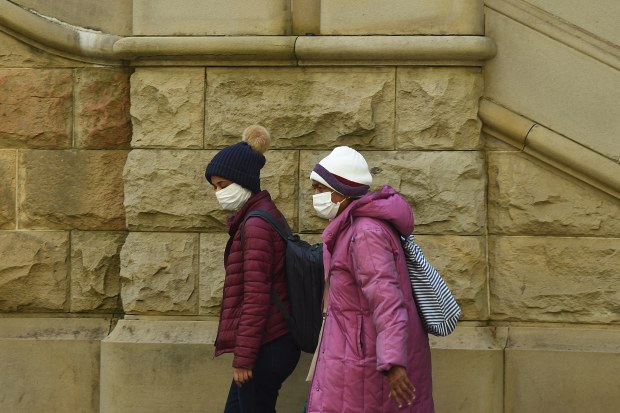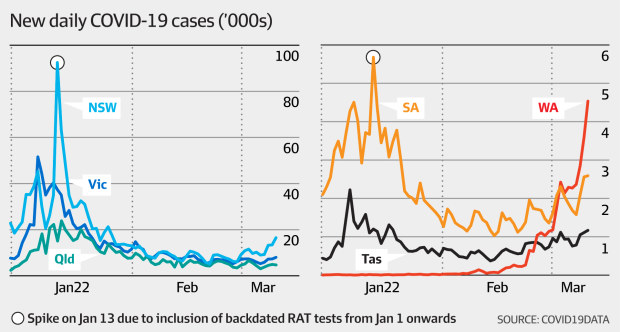From the AFR. Maybe somebody could let them about Viraleze?
The federal government will spend more than $2 billion to boost preparedness for Australia’s looming winter omicron infection wave, set to coincide with the country’s first serious flu season in three years.
Tens of thousands of new COVID-19 cases a day are expected around the country, with a major drive for booster injections and flu vaccinations set to begin within weeks.
Experts including Chief Medical Officer Paul Kelly have warned of a surge in cases this winter. Kate Geraghty
Experts are worried about a new strain of omicron – known as the BA.2 variant, which is more infectious than the original – as well the emergence of another variant of concern.
Friday’s meeting of national cabinet will consider a winter COVID-19 and influenza preparedness plan, as the Morrison government makes every effort to keep the nation’s economic recovery on track, reduce workforce shortages and slow infections in schools and social settings.
Central to the measures, requested by state and territory leaders ahead of winter respiratory disease transmission, is planning for the emergence of a new COVID-19 variant of concern.
The federal government has already agreed to extend the pandemic funding agreement with the states for a further three months to September 30 because of ongoing disruption caused by the omicron outbreak.
More than $9.9 billion has already been spent on additional hospital and health funding, part of a $41 billion federal government bill to cover increased health sector capacity and vaccine supplies.
Experts including Commonwealth Chief Medical Officer Paul Kelly have warned of a new surge in cases by about the middle of the year, predicting significant transmission among children who have never been exposed to a major flu season.
Before the emergence of COVID-19, influenza cases in Australia were reaching unusually high levels, with more than 313,000 notifications of laboratory-confirmed infections nationally and more than 950 deaths in 2019.
That rate was about 2.7 times higher than the five-year average but COVID-19 lockdowns and the closure of international borders stopped any major flu transmission in its tracks.
The states and territories are on alert for a new version of the virus that is 25 per cent more transmissible than the first omicron variant. NSW Health authorities on Thursday warned its rising dominance would see cases double to about 30,000 a day by as early as next month.
Sub-variant to take over
UNSW modeller James Wood said he would expect similar trends around the country from the BA.2 strain to be observed “within a couple of weeks”.
Testing on hamsters suggests the BA.2 variant reaches deeper into the lungs than the original BA.1 variant Australia had been experiencing. The research took place in Japan and is yet to undergo peer review.
However, the World Health Organisation (WHO) reported the “same studies also considered real-world data on clinical severity from South Africa, the United Kingdom and Denmark, where immunity from vaccination or natural infection is high”. It said relevant data found no reported difference in severity between BA.2 and BA.1.
WHO warned because of the higher transmissibility there would probably be proportionately more hospitalisation and deaths.
A recent study from Michigan State University forecast omicron BA.2 will become “another prevailing variant by infecting populations with or without antibody protection”.
The BA.2 sub-variant is nicknamed the “stealth” version of omicron because it is not detected by a PCR swab test. In the same way as the delta variant, it has to be sequenced in genomic labs, leading to delays in identification.
“BA.2 is about 25 per cent to 30 per cent more transmissible than the original omicron strain, so we expect it to be dominant by the end of this month,” Dr Wood said in an email.
“This is the main factor driving the rise in cases.”
Dr Wood said it was difficult “to predict the exact trajectory of the case numbers” but was confident cases in NSW would reach the 20,000 to 30,000 range in early April.
He indicated case loads would probably peak in May.
NSW cases have been rising steadily since bottoming out at 5822 infections in late February. Private estimates suggest the effective reproduction number is tracking at 1.28, meaning for every new case the BA.2 variant is spreading to 1.28 people, with cases doubling every two weeks.
Health Minister Brad Hazzard told a NSW budget estimates hearing on Thursday the BA.2 sub-variant was becoming the dominant omicron offshoot.
Mr Hazzard said preliminary data from the University of NSW indicated cases could more than double within six weeks.
“It’s very preliminary, and we need to do a lot more digging ... but we are concerned at this point that BA.2 is amongst us and overtaking BA.1,” he said.
‘Don’t switch off’
He warned the public had switched off from the virus threat.
“We’re still sitting way off, way off the booster doses that we need through the community,” Mr Hazzard said.
“People need to understand that while the community has gone to sleep on the virus, the virus hasn’t gone to sleep on the community.
“The virus is still out there, and it can wreak havoc if we don’t go and get our boosters fast.”
He called for people to get booster shots, noting NSW third jab rates had stalled at about 56 per cent of the adult population.
Nationally, nearly 12 million third doses have been administered so far.
Data analyst Mike Honey has been tracking the BA.2 variant through public genomic databases and reported that it is appearing in about 30 per cent of samples in NSW.
Denmark is the closest case study of a similar jurisdiction where BA.2 has become dominant, and it has experienced a big uptick in acute disease and death.
The analysis by Michigan State University researchers found the BA.2 variant to be 30 per cent more vaccine-resistant than BA.1 and 17 times more vaccine-resistant than the delta variant.
In Hong Kong, where the BA.2 variant is dominant, virologists and epidemiologists are still trying to understand what is causing a huge spike in deaths in the once COVID-zero city-state.
Death rates there are the highest in the world, with the city of 7.6 million people experiencing more deaths over the past week than the entire sub-continent of India had with its population of 1.4 billion.
Victoria’s genomic samples lag, so the data is behind but is tracking at about 20 per cent of cases.
Mr Honey said in Western Australia, BA.2 had a growth advantage of 11 per cent a day over BA.1, which he predicted would see it take over from the BA.1 variant in early March.
Western Australia has felt a surge of cases this week with 4535 new infections, up from 2095 a week ago.
National cabinet is also set to consider the growing Japanese encephalitis virus (JEV) outbreak in Australia on Friday, with the federal government pledging nearly $70 million in new spending.
Some 130,000 vaccine doses will be purchased to combat recent outbreaks in Queensland, NSW, Victoria and South Australia.
New modelling on the virus spread will be completed, along with mosquito control activities and laboratory capability planning.
Australia has recorded two deaths from the virus so far, as authorities warn people to avoid mosquito bites to reduce their infection risk.
New joint communications from the federal departments of agriculture and health will target farmers, meat workers and doctors with up-to-date information on the outbreak.
- Forums
- ASX - By Stock
- SPL
- New $2b plan to fight winter COVID-19 surge
New $2b plan to fight winter COVID-19 surge
- There are more pages in this discussion • 2 more messages in this thread...
You’re viewing a single post only. To view the entire thread just sign in or Join Now (FREE)
Featured News
Add SPL (ASX) to my watchlist
 (20min delay) (20min delay)
|
|||||
|
Last
12.5¢ |
Change
0.000(0.00%) |
Mkt cap ! $51.50M | |||
| Open | High | Low | Value | Volume |
| 12.0¢ | 12.5¢ | 12.0¢ | $4.689K | 38.55K |
Buyers (Bids)
| No. | Vol. | Price($) |
|---|---|---|
| 7 | 282553 | 12.0¢ |
Sellers (Offers)
| Price($) | Vol. | No. |
|---|---|---|
| 12.5¢ | 204674 | 6 |
View Market Depth
| No. | Vol. | Price($) |
|---|---|---|
| 7 | 282553 | 0.120 |
| 8 | 628274 | 0.115 |
| 6 | 197444 | 0.110 |
| 9 | 301213 | 0.105 |
| 10 | 301472 | 0.100 |
| Price($) | Vol. | No. |
|---|---|---|
| 0.125 | 204674 | 6 |
| 0.130 | 275658 | 9 |
| 0.135 | 69110 | 6 |
| 0.140 | 128397 | 8 |
| 0.145 | 200605 | 6 |
| Last trade - 15.21pm 07/05/2024 (20 minute delay) ? |

|
|||||
|
Last
12.5¢ |
Change
0.000 ( 4.17 %) |
||||
| Open | High | Low | Volume | ||
| 12.0¢ | 12.5¢ | 12.0¢ | 6138 | ||
| Last updated 14.09pm 07/05/2024 ? | |||||
Featured News
| SPL (ASX) Chart |
The Watchlist
I88
INFINI RESOURCES LIMITED
Charles Armstrong, CEO
Charles Armstrong
CEO
SPONSORED BY The Market Online







